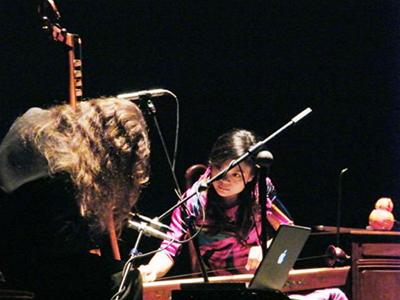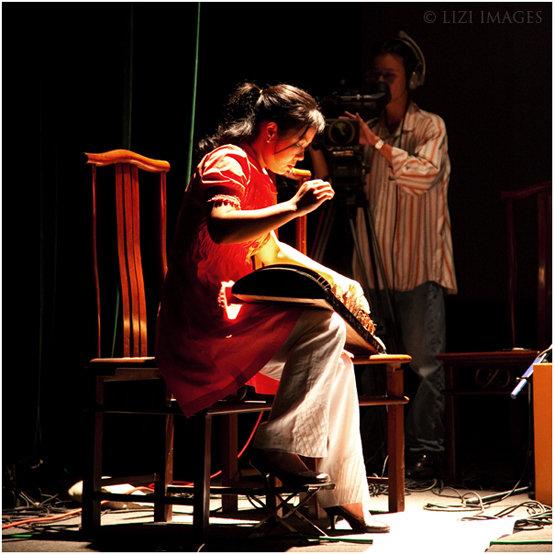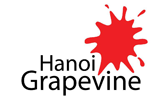Âm Nhạc Tạo Hình: Nhóm nhạc “The Six Tones” ở Hà Nội

20:00, thứ bảy 19/05/2012
Đền Kim Ngân
Thông tin từ nhạc sĩ Kim Ngọc:
Nhóm nhạc Việt Nam-Thụy Điển sẽ biểu diễn tại đền Kim Ngân 42 phố Hàng Bạc vào ngày 19 tháng 5 năm 2012 lúc 20:00. Khách mời: biên đạo múa Marie Fahlin và nhạc sĩ, nghệ sĩ biểu diễn Kim Ngọc Trần. Vào cửa tự do.Buổi biểu diễn này là sự khám phá mới lạ của âm nhạc tạo hình: âm thanh và các chuyển động tạo hình.
Nhạc sĩ Hà Nội Kim Ngọc với sự cộng tác của biên đạo múa người Thụy Điển Marie Fahlin đang phát triển một tác phẩm mang tên Chuyển Dịch (Movement) (2011-2012). Phần đầu của tác phẩm này sẽ được giới thiệu trong buổi biểu diễn thứ bảy ngày 19 tháng 05.
Trong/Ngoài (Inside/Outside), một tác phẩm sắp đặt được hình thành ý tưởng bởi Nguyễn Thanh Thủy với sự hỗ trợ của biên đạo múa Marie Fahlin- sắp được công diễn vào tháng 11 năm nay- cũng là một phần của đợt làm việc 6 ngày vừa qua. Kết quả đầu tiên – sẽ được giới thiệu trong phần hai của buổi biểu diễn- sẽ là một chuỗi các trình diễn ngẫu hứng sử dụng các hành vi của âm nhạc truyền thống ViệtNam như một điểm khởi đầu. Buổi biểu diễn sẽ kết thúc bằng một trình diễn ngẫu hứng tự do của các nghệ sĩ tham gia workshop. Sự kiện được tổ chức bởi E-Center (trung tâm âm nhạc và nghệ thuật thể nghiệm hà nội) và Nhà Sàn Studio với sự hỗ trợ tài chính của hội đồng nghiên cứu Thụy Điển và học viện âm nhạc Malmö, Thụy Điển.
The Six Tones
Tiếng Việt là ngôn ngữ thanh điệu, sử dụng sáu thanh âm khác nhau. THE SIX TONES là một dự án Thụy Điển/ViệtNamlàm việc lâu dài với trên nền tảng là sự hòa trộn âm nhạc của ViệtNamvà châu âu. Nhóm làm việc bằng cách chuyển soạn lại các bản nhạc truyền thống Việt Nam cho các nhạc cụ dây châu âu và các nhạc cụ truyền thống Việt Nam, trình diễn ngẫu hứng với nhạc điện tử sống và đặt hàng sáng tác các tác phẩm mới viết riêng cho nhóm từ các nhạc sĩ châu âu và Việt Nam. Nhóm The Six Tones bao gồm Thanh Thủy, Ngô Trà My- hai nghệ sĩ nhạc truyền thống điêu luyện của ViệtNamvà tay ghi ta người Thụy Điển Stefan Ostersjo. Từ khi dự án bắt đầu nhóm đã có sự cộng tác với nhạc sĩ, nghệ sĩ trình diễn ngẫu hứng Henrik Frisk, người vừa sáng tác tác phẩm mới cho nhóm, vừa đi lưu diên cùng nhóm với tư cách một nghệ sĩ ngẫu hứng nhạc laptop. Tham vọng chính của The Six Tones là tạo một nền tảng cho sự gặp gỡ của hai nền văn hóa khác biệt trên cơ sở bình đẳng. Xây dựng trên ý tưởng của sự học hỏi lẫn nhau, truyền thống âm nhạc Việt Nam và âm nhạc nghệ thuật châu âu được cùng nhau đưa vào âm nhạc nhằm mục đích vượt qua sự dán gép thông thường, để đấu tranh cho một tinh thần có định hướng thể nghiệm phức tạp hơn.

Marie Fahlin được đào tạo đào tạo múa đương đại tại tai trường phát triển múa đương đại (SNDD)Amsterdam. Từ năm 1988-1992 Fahlin đã sản xuất và công diễn gần 40 tác phẩm múa tại các sân khấu chính ở Stockhom. Năm ngoái cô đã thực hiện một chương trình đặc biệt tại các địa điểm công cộng kết hợp giữa âm nhạc, múa và nghệ thuật tạo hình. Công việc của Fahlin bao gồm các hình thức khác nhau từ các khúc múa solo trong im lặng trên sân khấu tới biên đạo cho các vở với 20 diễn viên ngoài trời tại thành phố Stockhom. Cô cộng tác thường xuyên với các biên đạo và các nghệ sĩ khác và cô cũng múa trong các vở múa của những biên đạo múa thú vị của Thụy Điển. Fahlin đã làm việc và biểu diễn ở My,Moldavia, Campuchia, Nauy va Brazin. Cô đã làm việc 2 lần tại Hà Nội và có những buổi diễn rất thành công tại nhà hát lớn Hà Nội. Fahlin đồng thời là giám tuyển và nhà tổ chức của dự án phát triển nghệ thuật và các liên liên hoan múa đương đại.
Kim Ngoc là nhạc sĩ sáng tác hiện sinh sống tại Hà Nội. Sau khi du học từ Cologne CHLB Đức, Kim Ngoc tiếp tục phát triển ngôn ngữ nghệ thuật của riêng mình thông qua rất nhiều các trình diễn tương tác với các loại hình nghệ thuật khác và sáng tác các tác phẩm music-theater. Các công việc gần đây có thể kể đến Sự Vắng Mặt -đặt hàng và sản xuất bởi liên hoan âm nhạc 10th Munich Biennale 2006, Ai Đem Con Nhện Giăng Mùng công diễn lần đầu tại liên hoan âm nhạc Ultima Festival, Oslo 2008, Cùng Nhau Đơn Độc – đặt hàng và sản xuất bởi Mehrklang Festival, Freiburg, Germany in May 2010… “Sự Chuyển Dịch” (Movement) là dự án cộng tác hiện nay của cô với nhóm The Six Tone trong khuôn khổ dự án nghiên cứu quốc tế Âm Nhạc Tạo Hình.
Vào cửa tự do.
![]()
| Đền Kim Ngân 42 Hàng Bạc, Hà Nội |

















Review: Gestures – The Six Tones in Hanoi.
The title of this work, and the manner in which it was described is a thing at once extremely rare to see in Hanoi, and then very familiar to me. I’m also pretty sure that the intentions and aspirations of this group are unfamiliar to Hanoi residents, being at odds with both the contemporary popular music scene in Vietnam and the current experimental music scene here. However much at odds with the audience this kind of performance might be, they presented it with no condescension or any attempt to simplify the concepts, an approach close to my own heart. The evening performance was set in the Kim Ngân temple on Hàng Bạc, a perfect, atmospheric setting. The huge wooden columns bearing up the immensely heavy layered tile roof and the hefty stone tiles bore a great contrast to the ethereal music that emanated from this group of musicians.
The only unnecessary (but also necessary, as I’ll explain in a moment) part of the evening was the first one. A lengthy explanation and discussion of the history of the group, along with a discussion of the development of the performance itself ensued. All of this could just as easily have been provided in the (already lengthy) programme notes, or … left out altogether, to nobody’s detriment. However, once a performance/project receives support from an institution – in this case the Swedish Research Council and the Malmö Academy of Sweden – it is suddenly required to produce a body of documentation, and justify every movement with sentences like “…music that aims to reach beyond a mere collage-like superimposition of elements…”. The reason I’m criticising this will become clear in a moment.
Three parts – three contrasting, but linked performances – split up the evening nicely. It began with a piece for đàn bầu (Ngô Trà My), đàn tranh (Thanh Thủy), and electric guitar (Stefan Östersjö). Single notes pierced the evening air amidst the wafting hubbub of Hanoi traffic floating in from the street beyond. Their gestures carefully extended the sound beyond the realm of hearing, visually tricking our ear through the gesture which so closely mimicked the method of sound production, or equally it could be describing the shape of the sound inscribed on paper.
A careful crescendo led to the second half of the first part which incorporated traditional Vietnamese melodies – Stefan Östersjö changing to đàn tỳ bà, the culmination of which led into a careful breaking down of the constituent parts and continuation of the sound world through fragmentation, and returning again to a ensemble restatement of melody.
The đàn bầu and đàn tranh performers then moved under the gateway, and the performance continued, beginning to incorporate more performer choreography, with them facing one another, turning to face away, replacing the instruments and incorporating mirrored gestures and more musical interaction.
After this all the performers moved outside to begin a joint performance. Marie Fahlin (dancer) and Kim Ngọc (composer/performer) joined, along with a drummer (no performer details, sorry), beginning gentle movements in the courtyard space, freely moving around and interacting with one another. There was so much to follow in this part of the performance, with gesture, movement and sound all interacting, that this could have become a entire performance of its own. As such, it was a perfectly timed concentration of collaboration and interaction, each performer perfectly at one with surroundings, instrument and sound. This was the most sublime moment of the performance, and it was the perfect culmination of the evening. To return to my original gripe, this is the reason that a programme note isn’t needed – the music speaks for itself. Why try to explain something that speaks louder than words?
I don’t think I have ever seen such an impassioned, considered performance in Hanoi. I’m looking forward to their November collaboration ‘Inside/Outside’, and hope we see a lot more of them in Hanoi.
They have a myspace page(!) with more information and a recorded track of their performance, but I’d strongly recommend you wait to hear them live if you didn’t see the performance last night.